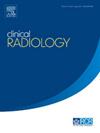One class classification-empowered radiomics for noninvasively accurate prediction of glioma isocitrate dehydrogenase mutation using multiparametric magnetic resonance imaging
IF 2.1
3区 医学
Q2 RADIOLOGY, NUCLEAR MEDICINE & MEDICAL IMAGING
引用次数: 0
Abstract
Background
Noninvasive detection of isocitrate dehydrogenase (IDH) mutations is crucial for preoperative decision-making in patients with glioma. While radiomics has been applied, data imbalance—specifically between IDH wild-type and mutated genes—remains underexplored. We developed a one-class classification-empowered radiomics (OCCR) model, trained exclusively on IDH wild-type patients, to distinguish them from IDH mutation cases.
Materials and Methods
This study included 495 patients from the UCSF Preoperative Diffuse Glioma MRI dataset. T1, T1ce, and FLAIR sequences were registered to T2 and resampled to a 1-mm isotropic resolution. The coregistered data were skull-stripped, and the tumor region was segmented using an ensemble model, followed by manual refinement. We extracted 386 radiomics features from the four MRI sequences and input them into an auto-encoder with 7 hidden layers for reconstruction. The OCCR model was trained on wild-type IDH patients, using the mean square error between the original and reconstructed features as guidance. During validation, reconstruction error was used to differentiate IDH mutations from the wild type.
Results
The hold-out validation demonstrated that OCCR performance improved as the number of training samples increased, achieving a peak area under the receiver operating characteristic curve of 0.8018. Visualization of reconstruction errors highlighted first-order and gray-level co-occurrence matrix features in the T1ce sequence.
Conclusions
This study demonstrates the feasibility of integrating one-class classification into radiomics for the determination of preoperative IDH mutation status in patients with glioma using multiparametric MRI. This versatile model holds potential for other diseases with substantial data imbalance.
求助全文
约1分钟内获得全文
求助全文
来源期刊

Clinical radiology
医学-核医学
CiteScore
4.70
自引率
3.80%
发文量
528
审稿时长
76 days
期刊介绍:
Clinical Radiology is published by Elsevier on behalf of The Royal College of Radiologists. Clinical Radiology is an International Journal bringing you original research, editorials and review articles on all aspects of diagnostic imaging, including:
• Computed tomography
• Magnetic resonance imaging
• Ultrasonography
• Digital radiology
• Interventional radiology
• Radiography
• Nuclear medicine
Papers on radiological protection, quality assurance, audit in radiology and matters relating to radiological training and education are also included. In addition, each issue contains correspondence, book reviews and notices of forthcoming events.
 求助内容:
求助内容: 应助结果提醒方式:
应助结果提醒方式:


